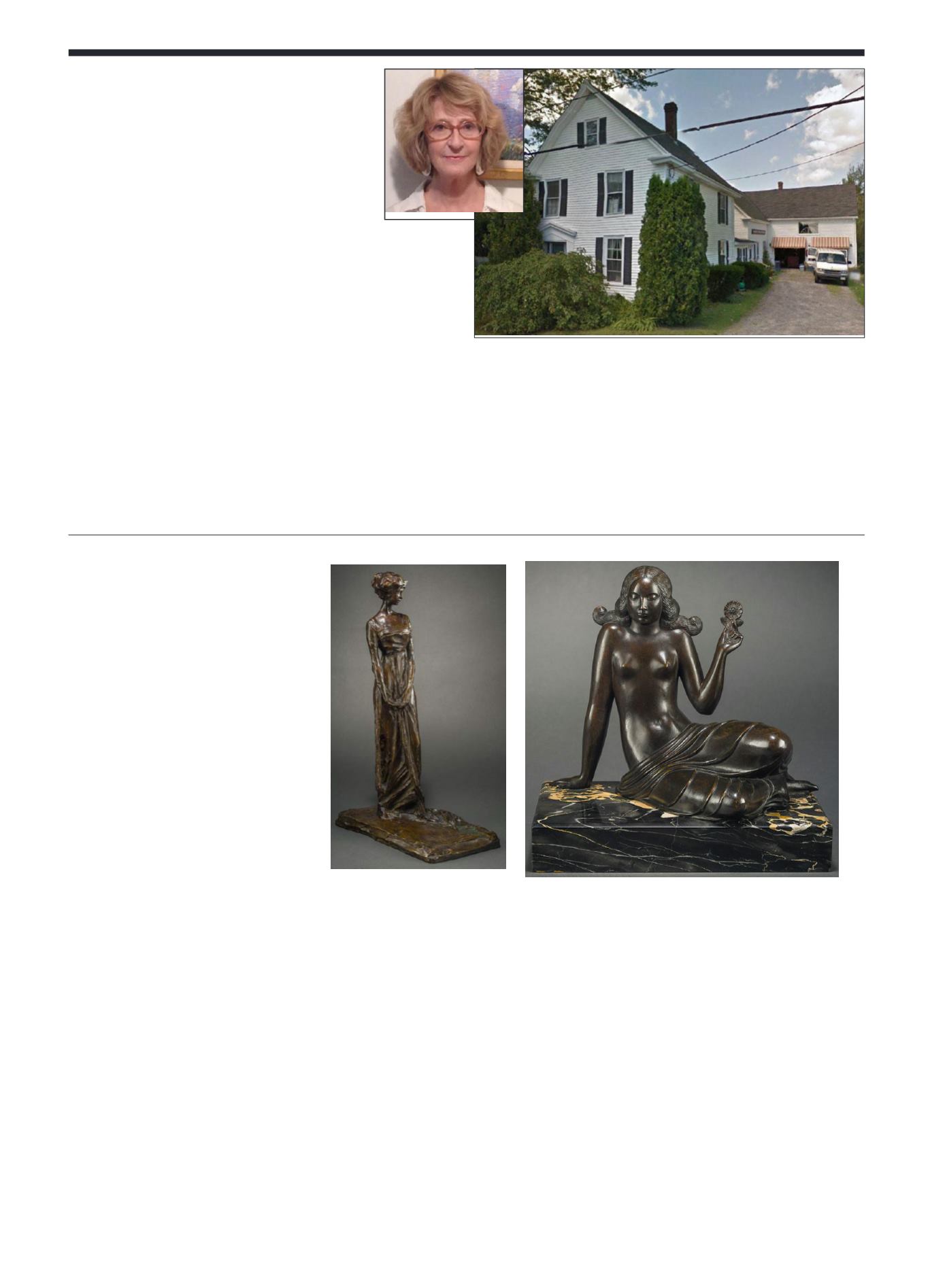

12-A Maine Antique Digest, April 2015
by Mark Sisco
T
he next time you’re driving on Route
1 into Searsport, Maine, take heed of
the 25 m.p.h. speed limit sign as you’re
approaching the town. Just south of the
center of town, slow down and notice the
big white house and barn with the red and
white awnings and the Pumpkin Patch
Antiques sign.
That’s where Phyllis Sommer has
staked her open flag for the past four de-
cades. April 25 marks the start of her 40th
year in the business, first as a single-own-
er antiques shop, and nine years later as a
group shop housing 12 high- quality deal-
ers. Phyllis started the business with her
husband, Robert, who passed away about
17 years ago, and Phyllis has been the
sole owner and head honcho ever since.
“My husband and I started it, and for
the first nine years, we just worked it
alone, and we were learning as we went
along,” she said. “We brought with us an
interest and a passion but not a tremen-
dous amount of knowledge.”
It was Robert’s idea to broaden the
appeal of the shop by bringing in other
dealers with other ranges of expertise.
So after nine years of husband-and-wife
operation, they brought in five exhibitors.
With the addition of a new barn, the num-
ber of dealers peaked in the late ’80s, and
now she’s settled into a comfortable level
of 12.
She’s a hands-on manager, and her
exhibiting clientele is loyal. Emery Goff
and Bill Carhart of The Old Barn Annex,
Farmington, Maine, have been with her
for the entire 31 years
of group operation.
Most of the low-end,
part-time, or semire-
tired players have long
since vanished, and
what’s left is a strong
assortment of commit-
ted displayers, each
with his or her own
special areas of inter-
est.
“We just realized that
this was something that
was working for us and seemed to be of in-
terest to the other dealers because we don’t
require that anyone tends the shop,” she
explained. “They’re not setting up a booth.
They drop it at the door. I get to decide if
something should or should not come in,
and also I get to do all the display work,
so everything’s blended.... I’m spoiled. It’s
like Christmas, when they drop off pieces
and boxes and I get to go through it and
rejoice in it.”
Sommer’s own passion is early period
furniture. “I love looking at it and break-
ing it down, just trying to understand
where it came from and how it was con-
structed and what that tells us about it....
It feels as though it somehow encodes the
lives of people who have touched it and
loved it or built it.” But don’t expect to
find a $75,000 Chippendale highboy here.
“Very high end is not something I can sell
very well here. And low end I don’t like,
and I don’t want. It’s not worth bothering
with. I’m always looking for that middle
ground where there are things of interest
but more affordable.”
We’ve all witnessed the “graying of the
trade,” so to speak, but Phyllis Sommer
sees lots of hope for an upcoming new
generation of antiques lovers. Often she is
asked if children are allowed in the shop,
and her response is that an inquisitive
child presents an educative opportunity.
“When children come in and they start
looking at something, there is an oppor-
tunity to engage in a conversation if they
feel comfortable with that, and those are
the things that have to happen so we can
foster the passion in these things.” She’s
also hopeful that the passion has taken
root with her son, who will probably be
the next family business manager.
“If you’re not [dealing] serious[ly], then
I think you’re kind of siphoning off pieces
that really are the livelihood of those of us
who are professional dealers, and we’re
making a living from it.” She concluded,
“Hopefully we’ll recover and we’ll all be
able to find the next generation.”
For more information, call (207) 548-
6047 or e-mail
<pumpkinpatch168@yahoo.com>.
Forty Years of Sommer
“I have a wonderful relation with the dealers who are in the shop. I like what they see and
buy and bring in. I’m spoiled,” said Phyllis Sommer.
by Lita Solis-Cohen
T
wo unique sculptures stolen 32 years ago in broad
daylight from Hirschl & Adler Galleries in New
York City were recovered, and one of them, Paul
Manship’s
Seated Female Figure
, was shown by
Hirschl & Adler at the ADAA Art Show at the Park
Avenue Armory March 3-8.
Seated Female Figure
(1916) by Paul Manship
(1885-1966) was stolen from a Hirschl & Adler ex-
hibition of sculpture on December 2, 1983, and just
three weeks later
Figure of Gertrude Vanderbilt Whit-
ney
(1910) by Paul Troubetzkoy was stolen from the
same show in the first-floor gallery of the townhouse
at 21 East 70th Street that Hirschl & Adler then oc-
cupied. The bronze sculptures are heavy but small
enough to fit underneath a trench coat.
The thefts were reported to the Art Loss Register at
the International Foundation for Art Research (IFAR)
and the Art Dealers Association of America (ADAA).
Each was valued at about $24,000. They are now
worth about five times as much.
The two sculptures were consigned for sale in De-
cember 2014 to Gerald Peters Gallery in New York
City, where Alice Levi Duncan, who heads Peters’
sculpture department, began to catalog them, expect-
ing to take them to the Winter Antiques Show. Duncan
said in a phone interview that she remembered she had
sold the Manship at Christie’s when she was head of
the sculpture department about 35 years ago. “I went
to my catalog and found that I had written Hirschl and
Adler was the buyer. I knew it was a unique piece, so
I called Hirschl and Adler and learned it had been sto-
len,” said Duncan on the phone.
Hirschl & Adler contacted Christopher Marinello at
Art Recovery International in London. After serving
as general counsel for the Art Loss Register for sev-
en years, in 2013 Marinello formed the London-based
partnership specializing in stolen, missing, and looted
works of art.
Marinello negotiated among all the parties and re-
solved this dispute. “He was very gentle with the con-
signors,” said Duncan.
The anonymous collector who consigned the sculp-
tures to Gerald Peters told Marinello the two sculp-
tures had been purchased at a store in the Diamond
District approximately 30 years ago; the collector was
unaware that they had been stolen and did not have a
receipt. The identity of the thief was never discovered.
The works were returned to Hirschl &Adler on Feb-
ruary 6, and the Manship was on the gallery’s stand at
the ADAA Art Show a month later. “It fit in with our
theme, Winold Reiss and Jazz Age Modernism,” said
Eric Baumgartner, vice president at Hirschl & Adler.
“We featured the work of Reiss and other Jazz Age
artists.”
The Manship is a smaller version of a figure that
appears in his monumental bronze sundial
Time and
Manship and Troubetzkoy Sculptures Recovered 32 Years after Being Stolen
Paul Manship,
Seated Female Figure
,
9¾" high x 11 5/8" wide x 6 5/8" deep,
on a 2" high marble base. It would fit
underneath a trench coat.
Paul Troubetzkoy,
Gertrude Vanderbilt
Whitney
, 21" high x 7½" wide x 12¾"
deep. Eric Baumgartner said the
sculptures were stolen before Hirschl
& Adler had a guard at the front door.
the Dancing Hours,
made for the
1939 New York World’s Fair
.
“
The
Seated Female
figure shows Man-
ship’s connection to archaic Greek
sculpture, seen here especially in the
stylized hair and simplified facial
features. Her pose is pure Art Deco,”
said Baumgartner. He noted that “the
small bronze predates more than a
decade Manship’s best-known public
monument art,
Prometheus
, the focal
point of Rockefeller Center in New
York.”
The sculptor and painter Prince
Paul Troubetzkoy (1866-1938),
whose father was Russian nobility
and mother was an American, lived
in Milan, taught in Moscow, and
moved to Paris in 1906, returning to
Lake Maggiore in the Alps during
summers. He made portrait busts and
statuettes of famous people such as
Tolstoy and Anatole France, and of
elegant women, including several
Vanderbilts. He lived in the United
States from 1914 to 1920 and then
returned to Europe. His best-known
work is a statue of Tsar Alexander III
in St. Petersburg in front of the Mar-
ble Palace. His bronzes of Vander-
bilts were included in an exhibition
of his sculpture at the Art Institute of
Chicago in February 1912 and at the
Detroit Museum of Art in February
1916.
“Cases like these should prove to
loss victims that is it never too late to
pursue a claim,” said Marinello in a
prepared press release. “Thirty years
is a long time for something to go
missing in the art world, but thanks to
more and more galleries undertaking
their due diligence we have a better
chance than ever of recovering long-
lost works of art.”
Marinello went on to say that the
legal process of determining owner-
ship in this case presented very few
obstacles. “Unlike the legal systems
in most European countries, it is a ba-
sic tenet of U.S. law that no individ-
ual can obtain good title to a stolen
work of art—even when purchased in
good faith. The law recognizes that a
stolen work of art is always stolen
property and therefore makes no ex-
ceptions for good faith, passage of
time, or the number of owners since
the theft occurred.”
According to Art Recovery Inter-
national this is not the first time Paul
Manship bronzes have been stolen
in New York City. In 1990 the
New
York Times
reported the recovery of
Aries and Taurus from the “Armillary
Sphere” series created for the 1964
World’s Fair. They had been stolen
along with six others from the same
series. All the missing Manships are
recorded on ArtClaim Database, the
sister business of Art Recovery In-
ternational. Loss registrations on the
recently launched ArtClaim Database
are free of charge to all users.
Art Recovery Group can be found
at 9 Clifford Street, London W1S
2FT. Visit the Web site
(www.artrecovery.com) or e-mail
<chris@artrecovery.com>.










